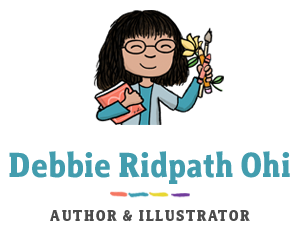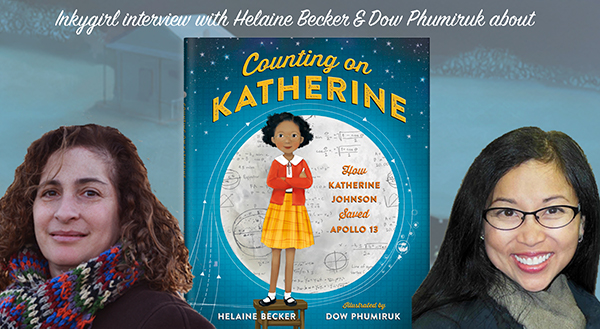
I met Helaine Becker through Torkidlit and Dow Phumiruk through the SCBWI, and I was so excited when I found out that they were collaborating on a picture book: COUNTING ON KATHERINE: HOW KATHERINE JOHNSON SAVED APOLLO 13. Their book is geared toward ages 5-9, launches from Holt Books For Young Readers on June 19, 2018 and has already garnered praise from publications like Kirkus and the Junior Library Guild. To those in Toronto: help celebrate COUNTING ON KATHERINE’s launch with Helaine Becker on June 23rd at the Ontario Science Centre!
Helaine and Dow were kind enough to answer some questions for me about their new book.
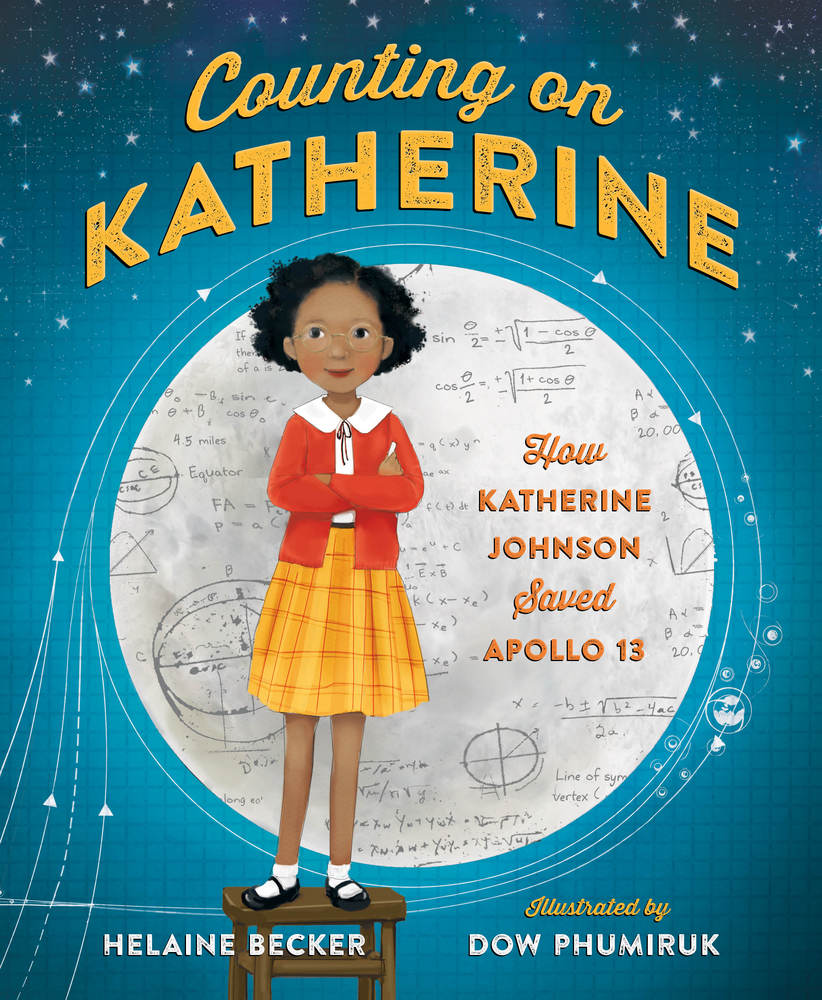
Q for Helaine: What inspired you to write COUNTING ON KATHERINE?
I was writing a book about Space for National Geographic Kids when I came across Katherine Johnson. Now this was well before Hidden Figures – there was almost nothing on Johnson, anywhere. I was gobsmacked, and utterly angry on her behalf. How come such an amazing woman, and such an important player in the rescue of Apollo 13, didn’t get a mention anywhere (let alone a role in the film)? I decided to rectify that matter.
It wasn’t easy to get a hold of Katherine – she was 96 at the time and didn’t exactly have a huge web presence or email addy. I sleuthed a bit and found what I thought was her home address and sent a snail mail letter telling her how much I admired her and asking if she would like me to write a book about her. About a month letter, I got a snail mail letter back from her daughter saying yes! They’d checked me out and decided I was an ok person to do the project since her grandson had a few of my books on his shelves and they were good. Whew! We kept in touch as I continued researching, and finally met in person a few months later when Katherine received a lifetime achievement award from the Women’s History Museum. I interviewed Katherine by phone a few weeks after that.
It was during this time that I got another letter that mentioned another “lady” who was writing a book about Katherine. That turned out to be Margot Shetterly, the author of Hidden Figures.
Q for Dow: How did you become illustrator for COUNTING ON KATHERINE?
I had just turned in final art for Jeanne Walker Harvey’s Maya Lin: Artist-Architect of Light and Lines for Christy Ottaviano Books. Christy thought we could follow up that book with another picture book biography of a strong and inspiring woman. She chose Helaine’s project for me. I’ve been counting my lucky stars for both of these opportunities, and for the privilege of working with Christy. When I read the description of Counting on Katherine, I was amazed both at learning about Katherine Johnson’s life story and at Helaine’s brilliance in seeking out an interview of this woman and her family for a book project.
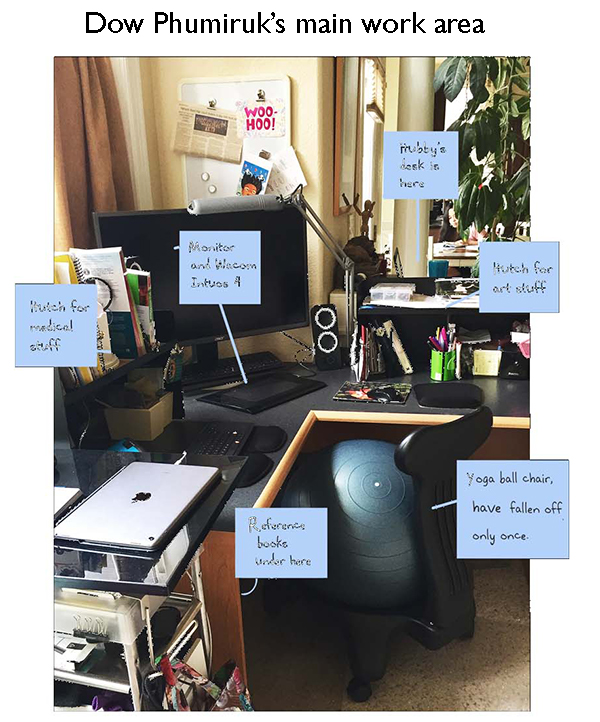
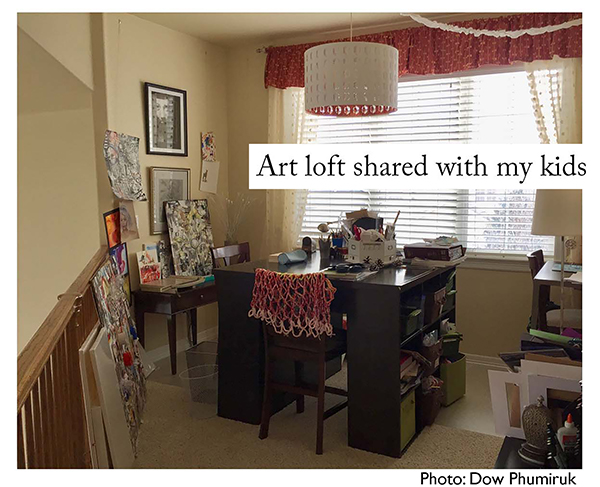
Q for Helaine: What was your process for writing COUNTING ON KATHERINE?
I researched like a madwoman. I dug through the depths of the internet to find everything I could about Katherine and her work – I had to understand what she did in order to explain it clearly to children. I also interviewed Katherine and her daughters, looking for the personal details that make a book come alive. And I watched hours of video – interviews etc., and made notes of at what point certain quotes were said so I could provide them to the fact checker.
When I sat down to write, I tried to summon up what I sensed was Katherine’s remarkable personality – a cool intelligence with a wry sense of humor and strong ethical core. I hope this picture of her comes across in the book. She may have been a math whiz, but she was a person first.
Q for Dow: What was your illustration process for COUNTING ON KATHERINE?
There is much research involved in drawing for nonfiction (or historical fiction) projects, from choosing appropriate background (scenery, props, and apparel styles/colors) to drawing a likeness of real people. This project challenged me with finding reference images for Katherine’s childhood in White Sulphur Springs, West Virginia, from early in the 20th century. I asked my editor if I could contact Helaine for references that she used to write her manuscript. Having her work combined with my own research was helpful. I read the Hidden Figures narrative nonfiction book by Margot Shetterly for more insight (she even described how Katherine would pose while she was thinking, which I incorporated into a drawing!). I looked through fashion ads for the era. I reviewed the history of NASA and our space program. And lastly, I started looking for sources for the math and technical data I would use in some of the art. I was able to find some charts that early computers filled out with their calculations and added my replica of those to a spread. I guess both Helaine and I researched like crazy!

After research, I cut and pasted Helaine’s text on top of a storyboard layout template and drew thumbnails. Then I sketched out each of the spreads, thinking about Katherine’s personality as I created the dummy. I cleaned up initial very rough drawings before submitting. After feedback and revisions on the dummy (see rough color sketch below), I started on final art.
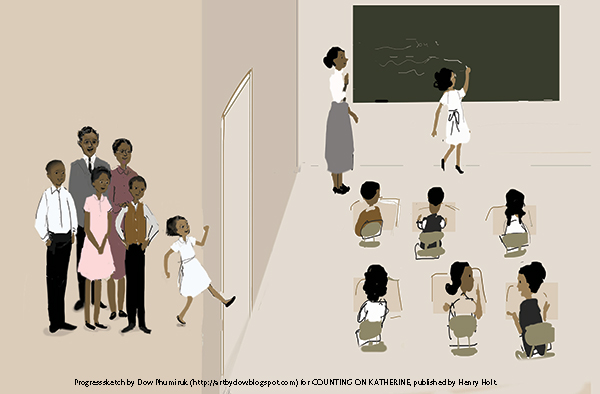
My art for this project was digitally created with paint textures scanned in. For example, I experimented with splattering acrylic paint to use for the Apollo 13 service module explosion and handwrote some of the math used on chalkboards throughout the book.
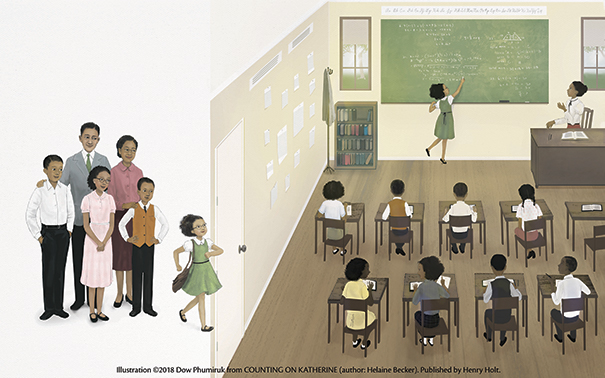
For our cover, I submitted several sample sketches But ultimately our book designer, Carol Ly, knocked it out of the park with the best version for our cover using art from my interior images. I loved her choice of colors! It is great reminder that books are created collaboratively. The art wouldn’t be nearly as polished without input from the team.
Q for Helaine: What advice do you have for those who are writing non-fiction picture books?
Research is paramount. Our facts need to be as accurate as possible – kids will carry the information you give them for the rest of their lives, and if you say something like “a pearl is made when a piece of grit gets inside an oyster,” they will believe the falsehood for the rest of their lives. So know your subject inside and out. Second – readers need to be able to care about the subject of the book. Always put yourself in a reader’s chair and ask yourself the questions that a reader might ask. Then answer them.
Q for Helaine: What advice do you have for young writers?
Write. All the time. The more you write, the better you will get. Don’t expect your work to be good – no one’s beginner work is much good. But what can you perfect if you have nothing on the page to revise? Write – and read. Then Write some more. Go back and revise your earlier work in light of what you have learned. Gradually, your writing will improve. Also – get some basic business skills. Writing and publishing is a business and if you don’t know the first thing about the sales process or about how publishing companies make money, you will have a much harder time threading your way to successful publication. This goes for traditional publishing as well as indie publishing. Last but not least – Writing is hard work – but so is everything else. If you’re willing to work at it – and throw out whatever doesn’t fit, a hundred times in a row if need be, eventually you will create something of value. Be brave. BE determined. And at all times, be close to chocolate.
Q for Dow: What advice do you have for young illustrators?
PRACTICE: Though you may be born with talent as an artist, there is still a journey to success in the industry you choose to pursue. In children’s books, you have to practice and achieve a marketable style, ideally one that tells a story and has wide appeal. Children’s book publishing, though full of some of the most vibrant and caring people, is still a business that must be sustainable.
If you are just getting started, practice by drawing anything you like! Experiment with all different types of media. You don’t necessarily know what your style is until you’ve teased it out by drawing all you can, and your work is recognizable. Also, practice will establish a solid foundation for art concepts like line, shape, value, and composition. You need this to create successful art! Then you can move on to the next bits of advice.
SHARE: Your work must be out into the world for editors and agents to find you. Keep that website updated. You will want to join the book creator community and hear the issues that are important to us. Network at conferences like SCBWI’s regional or international events or via online websites like KidLit411.
ADAPT: It’s a big responsibility to make a solid first impression with your art so that people will choose to pick up a book and proceed to read the great story behind the images. I can’t stress enough that you must be able to receive feedback thoughtfully and objectively. A friend of mine stated wisely (I am paraphrasing verbosely): if your art isn’t interpreted as you intended (no matter how good it is and what your own opinion of it is), you will want to contemplate if you can revise to convey your meaning in a way that is more universally readable and understood.
PERSIST: This is a handy word of late, and very practical for life. Many give up on the bumpy road to publication that has no guarantee of success. But if you stay in the game, growing your skills and knowledge base all the while, you will be ready for if and when that dream agent or editor looks your way.
ENJOY: Be patient, define success by your growth, and enjoy the journey. Remember that you are making the world a more beautiful place with your art!
MORE ABOUT THE ILLUSTRATOR AND AUTHOR:
Dow Phumiruk is an author and illustrator of children’s books. Dow is originally from Thailand but grew up in the United States. She now lives in the Lone Tree, Colorado with her husband, girls, and assorted small pets. When she is not creating, Dow teaches medical students and enjoys hiking. She is a member of the Society for Children’s Book Writers and Illustrators and is represented by East West Literary Agency. She is the illustrator of Maya Lin: Artist-Architect of Light and Lines, by Jeanne Walker Harvey (Christy Ottaviano Books), which has received attention as a Junior Library Guild Spring Selection 2017, an Amazon Best Book of the Year 2017, a recipient of a starred review from The Horn Book, and an NSTA Best Stem Book of the Year. In addition to Counting on Katherine, her other 2018 books include Mouse’s Christmas Gift, by Mindy Baker, which she illustrated (Zonderkidz, October 2018), and the recently released Mela and the Elephant, her author debut, illustrated by Ziyue Chen (Sleeping Bear Press). You can find out more about Dow and her work at her portfolio website, blog, Facebook, Instagram and Twitter.
Helaine Becker is the bestselling author of 80+ books for children and young adults, including the “enduring Canadian Christmas classic,” A Porcupine in a Pine Tree, and the giggle-inducing Ode to Underwear. Helaine’s award-winning STEM-related nonfiction includes Counting on Katherine: How Katherine Johnson Saved Apollo 13, Monster Science and Lines, Bars and Circles: How William Playfair Invented Graphs. She received the JLG nod for Worms for Breakfast and Zoobots and won the Silver Birch Award and Lane Anderson Award for Science Writing several times; she’s also won the Canadian Picture Book of the Year, the Information Book of the Year, California’s Eureka Award, and the Sydney Taylor Notable Book Award. Laugh out loud funny, Helaine is in high demand at schools and festivals internationally. Helaine volunteers for literacy organizations and charities including First Book, ABC Literacy, CODE and Librarians without Borders. She’s also a certified pyrotechnician, so expect fireworks at any time. You can find Helaine at her website, her blog, Twitter and Facebook.
For more insights from book creators, see my Inkygirl Interview Archives and Advice For Young Writers And Illustrators From Book Creators.

